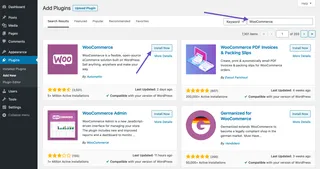Shopify vs WooCommerce


I’m going to be straight with you. WordPress isn't our favourite CMS. It’s not the popular opinion, but if you know MadeByShape, you know we don’t recommend WordPress for some good reasons.
That said, we like to give our clients all the facts and let them come to their own conclusions. It’s not uncommon that businesses approach us asking for a WordPress website, sometimes that’s simply because it’s the only CMS they’ve heard of.
If a business needs an online store to be built they have several options to choose from, namely Shopify, WooCommerce, or Craft Commerce. While our co-founder Jason gives a breakdown of Shopify vs Craft Commerce, this article looks at the comparison between Shopify and WooCommerce, the WordPress eCommerce platform.
Shopify is a hosted platform and acts as a comprehensive solution for creating an online store. Shopify websites are essentially created by selecting a template and theme which can then be tweaked and customised by a developer.
In a nutshell, Shopify is ideal for fast turnaround, budget-conscious individuals, for those who want a simple solution, and for smaller businesses that don’t have a very complicated stock. We favour Shopify for clients who fit this profile because they don’t get bombarded with complicated information in the CMS, and can keep good control over their online store’s functionality and aesthetic.
WooCommerce is an open-source plugin made for WordPress CMS. WordPress is the most used eCommerce platform, likely due to the fact that WordPress is the most widely used CMS (although, as I said, perhaps due to lack of knowledge about other options).
As a plugin, WooCommerce has its limitations. It acts as an extension of an existing website, not a website built-for-purpose in the way Shopify or Craft Commerce would allow. But, it is an easily customisable extension and one that many people opt for rather than switching their entire website over to a new platform.
So, how do Shopify and WooCommerce size up against one another? Here’s a quick overview of their differences:
Shopify | WooCommerce |
Create a website in as little as one week. | Create a website in anywhere from a couple of weeks to several months. |
$29/month for a basic package. | $13.99/month for a starter package. |
Free SSL certificate. | Free SSL certificate. |
Hosted on its own server. | No hosting is provided. |
24-hour customer support. | Ticket-based support system. |
Shopify Community provides additional support. | WooCommerce forum offers support. |
Budget is one of the first things on a clients mind when they approach anyone for a website build and with good reason. Knowing your limitations within budget is really important because it helps us figure out where we can pool our energies to deliver exactly what you have in mind.
When client’s approach us looking for a cost-effective option, Shopify is a good solution. Although Craft Commerce is our eCommerce platform of choice, its highly bespoke approach means we spend more time building unique elements, specially designed for your business. This is great but it’s not always necessary, For smaller online stores and those looking for an eCommerce website on a smaller budget, Shopify is a great option.
As you can see, WooCommerce is even cheaper than Shopify. That’s good, but if we look a bit closer having a WooCommerce website risks racking up bills in other areas, for example
Premium plugins often need to be purchased in other to reach the client's desired functionality. Features such as bookings, subscriptions, and customising product listings can require premium plugin licenses, sometimes amounting to $500 per year.
Shopify is a hosted platform, meaning you don’t need to worry about additional server costs. This is not the case with WooCommerce which can eat up valuable space on a separately paid-for server.
Shopify | WooCommerce |
Basic: $29/month | Starter: $13.99/month |
Shopify: $79/month | Plus: $17.99/month |
Advanced: $299/month | Pro: $31.99/month |
Usability is important on two levels:
To help developers build your website swiftly and allow freedom of customisation where needed.
To make it easy for business owners to navigate, and make changes to, their own website.
One of Shopify's benefits is that it’s built for ease of use. The user interface of the CMS is intuitive and naturally picked up even by those who don’t use the computer very much. Choosing from a selection of themes and templates makes it easy to decide how you want your website to look. We can tweak these elements, but having a menu of looks to choose from stops the task from becoming overwhelming for some, especially people who aren’t visual thinkers.
For non-developers, the drag-and-drop interface makes it super easy to add content and customise elements, but it also means you’re faced with a level of limitation. That’s why it's best to enlist the help of a developer who can tweak your template in the backend. Our developers like Shopify because it’s easy to use even when we’re making our own edits to your website.
While WooCommerce mirrors Shopify’s freedom of customisation, it sometimes feels like you’re drowning in options. WooCommerce requires much more hands-on management, plus there are other aspects that need to be addressed. Hosting, updates, security, and backups are left up to the individual or the developer to handle. All of this extra legwork makes WooCommerce a more stressful option for clients and a more time-consuming platform for devs.
Plugins are great. They allow us to quickly inject a new feature or functionality into a website. There are plugins like Shipstation which virtually every website benefits from, but it prevents us from needing to individually code that feature into the website each time, saving time and money for the client.
Shopify makes plugins (or apps) easy. They can be bought through Shopify’s app store and its powerful API makes its apps robust and responsive. There are free and paid apps available through an app store, with some created by Shopify itself and others built by third-party developers.
Shopify’s plugins are backed by a fantastic customer service offering. 24-hour support through live chat, emails, and callbacks means that there’s always someone ready to help if an app goes south for whatever reason, or we need a question answered. For third-party apps, it’s a different story but customers are somewhat protected by user ratings, detailed support material to download, and the fact that getting a plugin approved by Shopify is no easy feat.
WooCommerce on the other hand has a much lower standard of approval for plugins. This means that users have access to a lot more plugins, but whether they are all of the same quality is debatable. Furthermore, two independently created plugins can clash when combined on one website.
The larger selection of plugins leads some to believe that WooCommerce is more customisable, but this really depends on who is customising the site. If it’s up to a professionally trained developer, plugins aren’t always necessary, just more convenient in some cases.
I took a closer look at our favourite Shopify plugins in my article, and Tom covered Shopify plugins in a bit more detail in his article A Look at Shopify.
Both Shopify and WooCommerce can be scaled but they are not equal. To scale up a Shopify store you just need to upgrade your plan to Shopify Plus. Shopify handles all the security as you go so there’s no need to worry about this. But Shopify can only really scale to an extent as it relies on plugins to handle multiple aspects that become necessary as the business and store grow.
While scaling up your WooCommerce website, your starter hosting plan wouldn’t be able to handle traffic after a certain point. The self-hosted platform means it’s the user's responsibility to handle back-ups, updates, and security while scaling up and this can become a headache.
When clients approach us because their Shopify or WooCommerce stores have outgrown the platform, this is when we start to look at Craft Commerce for the next step. With Craft Commerce, we can set a business up with multiple stores having different regional languages under one easy to manage control panel. This is something that comes with Craft Commerce as standard.
In conclusion, we recommend Shopify over WooCommerce. It’s a simplified, efficient, cost-effective option that doesn’t scrimp on quality and supports for users of all levels and abilities. If you’re curious, here’s how we build a Shopify website, step-by-step.
Or you could just make your mind up now and give us a ring.

Woocommerce plugins at a glance
Hello, I'm Natasia, and I'm a content writer for Shape.